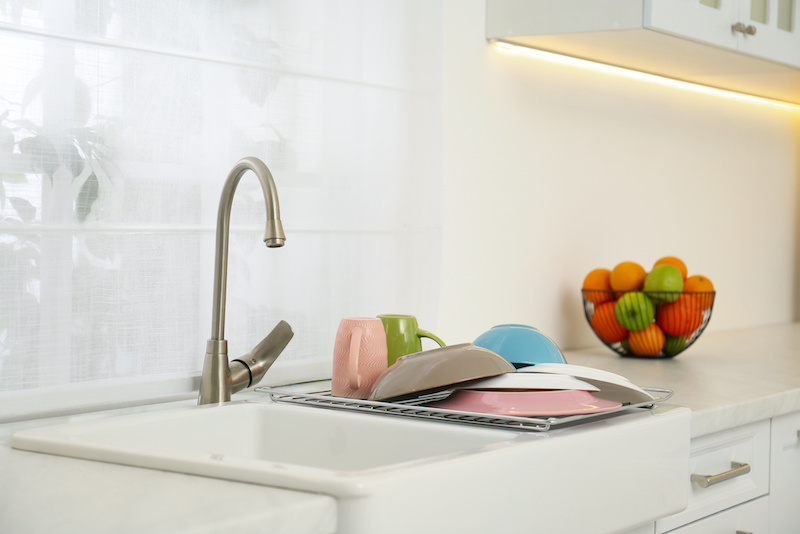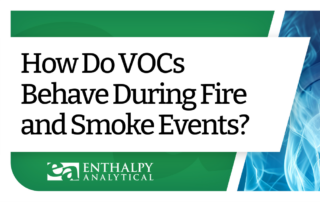
Commercial Indoor Air Testing
Introduction
Enthalpy provides commercial indoor air testing services for a variety of air quality concerns and in many different settings. For over 25 years, our advanced lab and commercial iaq testing technology have benefited Fortune 500 companies and IAQ professionals across the country and internationally.
We average 12-16 breaths per minute. How much do you know about the quality of the air you breathe in the most common environments where you spend your time?
Enthalpy offers comprehensive testing solutions that will give you a total assessment of the air you breathe every day. Whether you need to test the air in your own home, want to ensure your team has healthy air to breathe in the office, or need to test for specific air contaminants like mold, formaldehyde, or carcinogens, Enthalpy can help determine which analysis is best for your air quality concerns.
Why test?
IAQ by Type
IAQ HOME SURVEY™
Home air quality is a growing health issue throughout the US. Most homeowners and potential home buyers are not aware there is an accurate and inexpensive way to determine the level of unwanted chemicals in home air. Additionally, many states and lending institutions now recommend that a home air quality audit be performed during a property sale.
Residential air quality can be challenging to assess because of the variety of building types, conditions, and possible VOC sources. Our IAQ Home Survey™ is an accurate, simple to use and cost-effective tool for use in determining airborne chemicals (VOCs) and active growing mold (MVOCs) in home air. With a single sample, IAQ Home Survey™ reports the air quality via the total levels of VOCs (TVOC) and MVOCs (TMVOC). Most importantly, the chemical information is translated into categories of potential sources. This allows an action plan for improving air quality to be developed. In the case of a real estate transaction, it identifies the chemical contamination contributed by the home itself.
IAQ Home Survey™ is a cost-effective tool for indoor air quality assessments. It is particularly useful in real estate transactions. A home inspector can easily and cost- effectively perform an air audit in conjunction with the home inspection.
Click to view our full list of IAQ Home Survey™ test options.
COMMERCIAL BUILDINGS, OFFICES, RETAIL, RESTAURANTS, WAREHOUSES
Work environments can contain a myriad of sources that produce unwanted chemicals (VOCs) in the air. Couple that with insufficient ventilation and the resulting air breathed by building occupants can affect productivity, work quality, and worker health. Most people spend a lot of time in commercial and office buildings so indoor air quality complaints and problems must be addressed.
We offer a comprehensive portfolio of air testing for VOCs. This allows for detailed investigations that are determined by the specific issue. In addition to these customizable tests, we offer VOC air quality testing used for green building certification (LEED, WELL, LBC, etc.) and the IAQ Commercial Survey. IAQ Commercial Survey is a simple but comprehensive air test that can determine the extent of unwanted chemicals (VOCs) and it also predicts the sources of these chemicals. By knowing the sources, an action plan can be developed and implemented that will lead to a healthier work environment.
Eliminating unwanted chemicals creates better-quality air. This leads to increased worker productivity, job satisfaction, and an overall healthier workforce.
INDUSTRIAL & MANUFACTURING
There can be many common industrial air pollutants, including dust, soot, smoke, carbon monoxide, lead particles, nitrogen dioxide, and sulfur dioxide. According to the EPA, we spend about 90% of our time indoors. With industrial buildings containing significant amounts of air contamination sources and inadequate air ventilation systems, exposure to air pollution becomes problematic for many workers and decreases productivity and work quality. Regular exposure to poor indoor air quality can cause many health effects, ranging from mildly irritating to serious health impacts.
Enthalpy offers many options for investigating employee and/or occupant complaints, odor concerns, and determining general indoor air quality with full spectrum Volatile Organic Compound analysis. Let us help you develop your IAQ policy from start to finish.
Indoor air investigations can be challenging. There are many aspects to indoor air quality, including volatile organic compounds (VOCs), inorganic compounds, particulates, allergens, comfort factors, etc. One of the most difficult areas to look at is the VOCs, which are organic chemicals (containing primarily carbon and hydrogen) that vaporize easily at room temperature. There are thousands of different VOCs in indoor air from hundreds of sources, making both source identification and remediation plans challenging.
Most people do not notice an indoor air quality problem unless they smell something unpleasant or feel ill but many VOCs have no noticeable characteristics, leading to poor air quality situations without any perceptible signs.
In developing an action plan for resolving VOC issues, it’s not sufficient simply to know which chemicals are present. Understanding the sources as well as how the VOCs will react to changing conditions is crucial to improving air quality. Because air quality is such a complex issue it is important to have a clear goal in mind when preparing a sampling strategy.
Here are a few key questions to ask yourself:
- What’s the problem or purpose? Odor, physical symptoms, real estate transaction, monitoring, simple curiosity?
- Is the problem present all the time or is it specific to a particular location/time/activity?
- Have any new products, activities, or environmental conditions been introduced recently?
- Is the effect limited to one person or is everyone affected?
- Do you need an overview of the VOCs or more detailed chemical information?
Enthalpy offers a wide range of sampling and analysis options to address your indoor air concerns.
Molds are fungi that grow in the form of multicellular filaments called hyphae that spread to form a network or colony called mycelium. There are thousands of known species of molds, although a much smaller number of mold species are commonly found in indoor environments.
Water intrusion and moisture are key elements that cause mold growth. Often these conditions originate from leaky pipes behind walls or under floors, roof leaks, improperly installed windows or excessive humidity. In many cases, these conditions are non-observable – we just don’t know they exist.
Whether mold is visible or not, i.e., “hidden mold,” certain chemicals called mold volatile organic compounds (MVOCs) are produced as the mold digests its food. Prolonged exposure to these VOCs can have serious health effects especially in infants, small children, the elderly and anyone with chemical sensitivities or chronic respiratory conditions like asthma or allergies. Because mold VOCs are produced as the mold grows, they can be used as an indicator of active mold.
Enthalpy offers a number analysis options that include mold VOCs.
The complexity of air quality testing for green building certification (LEED, WELL, LBC, etc.) and subsequent compliance, in most cases, comes down to your TVOC and Formaldehyde levels. With so many products and factors contributing to the VOC levels in your ‘Green Building’, how can you be sure that you have found the source?
Enthalpy offers varying levels of detail to fit your pricing constraints for air quality testing used for green building certification (LEED, WELL, LBC, etc.) Enthalpy is your laboratory partner in helping achieve success and pass VOC guidelines for certification. Contact us to discuss your upcoming LEED, WELL, Living Building Challenge, BREEAM, or other green building program projects.
One of the most difficult challenges in cleaning up after a fire is determining the level of remaining fire and smoke residue. We typically are aware of these residues as visual traces (e.g., soot, char, or ash on surfaces), smoky odors, or health effects (e.g., burning eyes, difficulty breathing, etc.).
There are two primary concerns with fire and smoke residue:
- Has the fire or smoke residue been removed to an acceptable level?
- Are there any health or exposure concerns with any remaining traces?
Fire produces a complicated mixture of particulates (soot, ash, and char) and chemicals that makes a comprehensive analysis challenging. By combining analyses of these major components, a far better and more inclusive picture of the residues can be accomplished.
There are two primary fire situations, indoor or structure fires and wild fires. Indoor fires are complicated by the contents and building materials, as well as the level and strength of the fire. Wild fire smoke can travel long distances and impact buildings miles away from the main fire.
Our capabilities include air sampling, technical review, particulate sampling, and material sampling. Contact our team for assistance with planning your upcoming project or to learn more about fire and smoke residue testing.
WHAT’S THAT SMELL? Our sense of smell can be amazing and annoying at the same time. Many of us can detect certain odors that are annoying, bothersome, and can even make us sick. More importantly determining the source of the smell can drive us crazy! We come into contact with many scents all throughout our day. What happens if the odor is in our home or work environment where we spend a majority of our time? Some VOCs can be odorless but many do have an odor & odor threshold. To remove the source of the offensive odor we must first find what it is coming from.
An odor, smell, scent, or fragrance is caused when one or more volatile chemicals enter our nasal passages and are detected by specialized receptors. These can be interpreted as pleasant or unpleasant, as well as variations in description such as flowery, spicy, ethereal, acrid, musky, etc.
Our knowledgeable technical staff and solutions-based analyses can help to determine the point source odor and vapor problems. Enthalpy offers varying levels of odor detection/solution analyses from our Survey line of products to our 500+ compound Comp-Air report.
Let us help you determine which analysis option best matched your application.
Agencies such as the EPA and the National Cancer Institute are stating that above certain levels of formaldehyde in the air (0.1 ppm or 100 ppb) individuals may experience adverse health effects. But how do we know the levels of formaldehyde in our environment?
When formaldehyde is present in the air at levels exceeding 100 ppb, some individuals may experience adverse effects such as watery eyes; burning sensations in the eyes, nose, and throat; coughing; wheezing; nausea; and skin irritation. Some people are very sensitive to formaldehyde, whereas others have no reaction to the same level of exposure. In addition to the immediate symptoms, formaldehyde is classified as a Group 1 carcinogen, known to cause cancer in humans, by the International Agency for Research on Cancer (IARC).
One of the complicating factors in formaldehyde investigations is the variety and number of sources. There are a surprising number of sources in various building materials, everyday products, and natural processes. Let our team of experts help you identify potential sources of formaldehyde.
Solving poor indoor air quality mysteries can be quite a task. There are many possible sources within our indoor environments contributing to the chemical makeup of the air we breathe. When there has been recent construction or a new process implemented, we can usually gain a better handle on what is causing the IAQ issue. How can you be sure that you have narrowed down the culprit?
Material off gas analysis can help determine which product is creating the concerning VOC’s we find in the air. Chemical specific and full spectrum analyses are available. Enthalpy can analyze both solid and semi-solid materials; such as flooring, carpet, insulation, clothing, furniture, bedding/mattresses, etc. This valuable data can then be cross referenced with the VOC air analysis to determine if the chemical signatures or fingerprints are the same.
Providing detailed analysis of the air and material source will allow the cleanup/containment work to begin. Contact us for assistance with planning your upcoming project or to learn more about bulk material off gassing.
IAQ by Application

View Our Recent Blog Post
Click to View Sample Reports
Equipment & Shipping Labels
Indoor Air Sampling Instructions
Indoor Air Sampling Certification
Work with experts who deliver reliable laboratory data and insights.
Request a quote or email us your analytical testing or permitting question and one of our team members will be in touch shortly!


